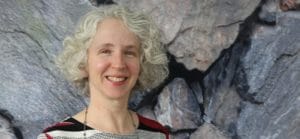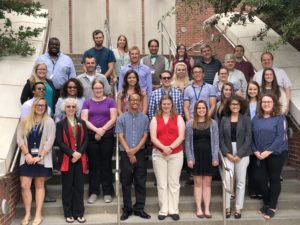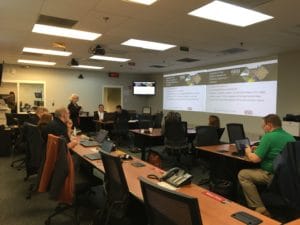Daphne LaDue
 Dr. Daphne LaDue is a senior scientist at the University of Oklahoma’s Center for Analysis and Prediction of Storms. Her background is very quantitative. She first pursued a B.A. in Physics from a small liberal arts college in Indiana with the goal of being a high school physics teacher. She had taken physics during her last year of high school and it was one of the most difficult — but fun — classes she had ever had. Being a physics and math teacher sounded great. Her parents, though, encouraged her to see what else was out there before fully committing to the education degree, and sure enough, she was intrigued enough to pursue the straight physics degree. She participated in the Indiana University Cyclotron Facility’s Research Experiences for Undergraduates program in 1988, and that helped her figure out how to explore more of what physics had to offer.
Dr. Daphne LaDue is a senior scientist at the University of Oklahoma’s Center for Analysis and Prediction of Storms. Her background is very quantitative. She first pursued a B.A. in Physics from a small liberal arts college in Indiana with the goal of being a high school physics teacher. She had taken physics during her last year of high school and it was one of the most difficult — but fun — classes she had ever had. Being a physics and math teacher sounded great. Her parents, though, encouraged her to see what else was out there before fully committing to the education degree, and sure enough, she was intrigued enough to pursue the straight physics degree. She participated in the Indiana University Cyclotron Facility’s Research Experiences for Undergraduates program in 1988, and that helped her figure out how to explore more of what physics had to offer.
She pursued an M.S. in Atmospheric Science from the University of Wisconsin-Madison, realizing that weather was a really interesting application of physics. She was offered a Ph.D. position near the end of her master’s work, but was unsure that she had quite found her niche just yet, so she went into the workforce, with either contractor or university-funded positions for NASA and NOAA. Through these first few years of her early career she conducted applied research, and eventually moved into outreach. She also programmed a web site application that plotted annual cycles of severe weather and this helped her focus back on how people were understanding and using weather information.
Realizing her strong interest in social aspects of weather information, Dr. LaDue shifted her focus: conducting qualitative research and earning a doctorate in Adult & Higher Education at the University of Oklahoma. She focused her dissertation on how weather forecasters learn to forecast the weather by conducting in-depth interviews. She still loves being situated in a heavily quantitative environment and having colleagues who enjoy playing with numbers, but she hasn’t done as much with quantitative social science. There is only so much time in a day! She’s instead found herself enamored with research that can explain HOW and WHY something is the way it is, to understand with the richness and depth that only qualitative research can yield.
Most of her time these days is spent conducting research at the intersection of emergency management and severe weather, with the goal of helping the weather enterprise improve severe weather forecast and warning information to help key decision makers. One major project called the Prototype Probabilistic Hazard Information Project was testing an experimental way to issue severe weather and tornado warnings by having NWS forecasters and emergency managers work through case studies and live weather events to try the concepts in a simulated practice. Her other major projects have been funded under NOAA’s VORTEX SE initiative (https://www.nssl.noaa.gov/projects/vortexse/), where severe weather and tornado research efforts are focused on the challenging southeast U.S. environment.

Dr. LaDue, second from left in the front row, poses with her 2018 REU participants and their mentors. Three of the mentors in the photo are also alumni of her program.
She has also been the PI and Director for an NSF-funded Research Experiences for Undergraduates Program (https://www.caps.ou.edu/reu) at the University of Oklahoma since 2001. Her program now has about 250 alumni, with about 200 of them having gone through the program under her directorship. With her own unique and winding career path in mind, one of her greatest satisfactions is helping undergraduates explore the myriad career opportunities in and around atmospheric sciences to help them find a good career fit.
There weren’t many women in the field when she first completed her Master’s work in 1992, though she had the pleasure of working in a mixed-gender environment with several other relatively young scientists in her first position as a contractor at NASA’s Langley Research Center. She found the Washington, D.C., area to be similar before moving to Norman, Oklahoma. That was around the time that ESWN was born, providing vital companionship, even if it was virtual. It continues to provide wonderful encouragement and help. There are many women coming up in the ranks behind her now, something she is happy to see, but she would like to see the scientific workforce better mirror the larger population in more ways than gender. She has had some challenges, but has been grateful for many good colleagues who have encouraged her and helped provide opportunities.

